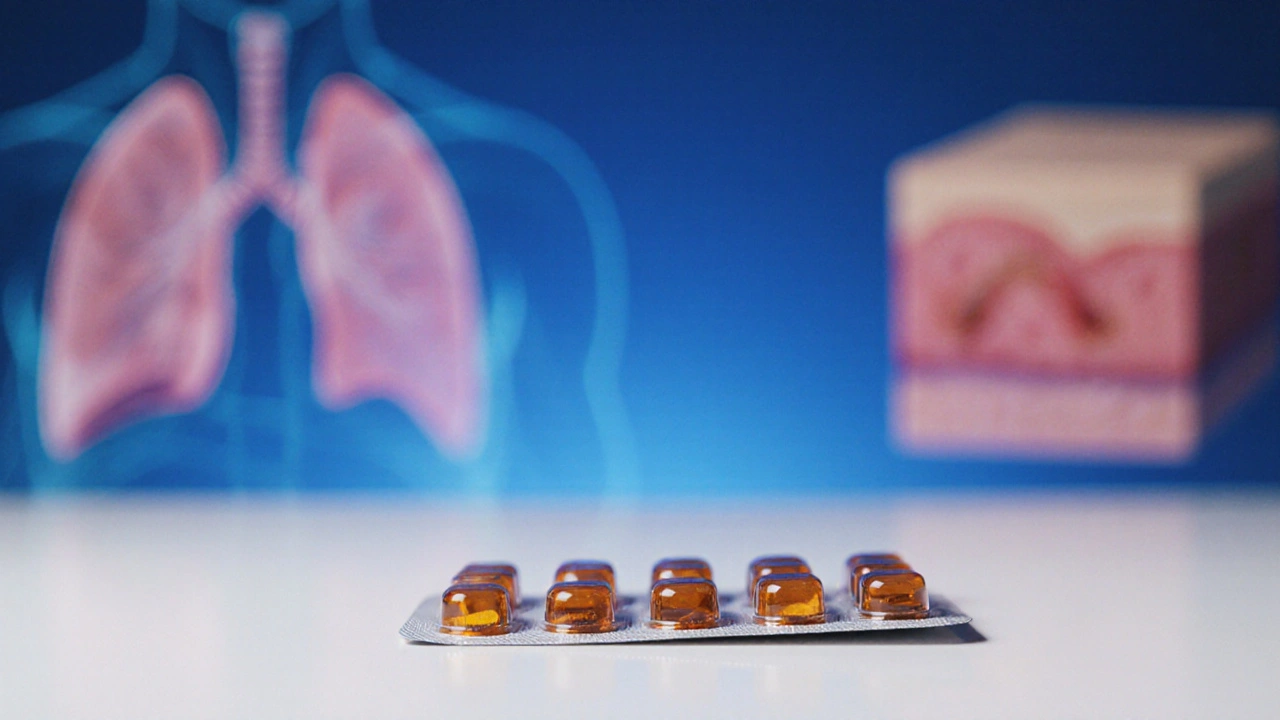Key Takeaways
- Biaxin (clarithromycin) is a macrolide antibiotic with strong activity against respiratory and skin infections.
- Azithromycin, doxycycline, levofloxacin and amoxicillin are the most common alternatives, each with its own strength and drawback.
- Consider drug‑drug interactions, side‑effect profile, dosing convenience and cost when choosing.
- For patients with liver disease or QT‑prolongation risk, Biaxin may not be the safest option.
- Short‑course regimens (e.g., azithromycin) can improve adherence for uncomplicated infections.
When doctors need an antibiotic that can tackle a range of bacterial infections, Biaxin is often on the list. Biaxin (clarithromycin) is a macrolide antibiotic that works by stopping bacterial protein synthesis.
What Is Biaxin (Clarithromycin)?
Clarithromycin belongs to the macrolide class and was first approved in 1991. It’s typically prescribed in 250mg or 500mg tablets taken twice daily for 7‑14days, depending on the infection.
How Biaxin Works
The drug binds to the 50S subunit of bacterial ribosomes, preventing the elongation of peptide chains. This action is bacteriostatic for most organisms but can be bactericidal at higher concentrations. Because it targets protein synthesis, it’s active against many Gram‑positive, some Gram‑negative and atypical bacteria such as Mycoplasma pneumoniae.
Typical Indications for Biaxin
Doctors commonly use Biaxin for:
- Community‑acquired pneumonia
- Acute bacterial sinusitis
- Skin and soft‑tissue infections
- Helicobacter pylori eradication (as part of triple therapy)
Its good tissue penetration makes it a favorite for lung and skin infections, especially when patients can’t tolerate penicillins.

What Are the Main Alternatives?
Below are the most frequently considered substitutes, each with a short profile.
Azithromycin is another macrolide, known for its long half‑life that allows once‑daily dosing. It’s often chosen for uncomplicated respiratory infections because a typical 5‑day course is easier to complete.
Doxycycline is a tetracycline antibiotic with broad coverage, especially against atypical organisms and certain resistant strains. It’s taken twice daily, but food can reduce stomach upset.
Levofloxacin belongs to the fluoroquinolone class and offers high oral bioavailability and a convenient once‑daily dosing schedule. It’s potent against many Gram‑negative bacteria but carries a higher risk of tendon injury.
Amoxicillin is a beta‑lactam penicillin that remains the first‑line choice for many ear, nose, throat and urinary infections. It’s safe, inexpensive, and works well unless the pathogen produces beta‑lactamase.
Macrolide antibiotics as a group share a similar mechanism but differ in spectrum, half‑life and side‑effect profile. Understanding the nuances helps avoid cross‑resistance.
Side‑Effect Profile Comparison
All antibiotics have pros and cons. Here’s a quick snapshot:
| Attribute | Biaxin (Clarithromycin) | Azithromycin | Doxycycline | Levofloxacin | Amoxicillin |
|---|---|---|---|---|---|
| Class | Macrolide | Macrolide | Tetracycline | Fluoroquinolone | Beta‑lactam |
| Typical Dose | 250‑500mg bid | 500mg daily (5days) | 100mg bid | 500mg bid | 500mg tid |
| Key Spectrum | Respiratory, skin, H.pylori | Respiratory, atypicals | Atypicals, Rickettsia | Gram‑negative, severe CAP | Streptococcus, H.influenzae |
| Common Side Effects | GI upset, taste alteration, QT prolongation | GI upset, mild liver enzyme rise | Photosensitivity, esophagitis | Tendon rupture, CNS effects | Diarrhea, rash |
| Drug Interactions | Strong CYP3A4 inhibitors/inducers | Fewer CYP issues | Calcium/iron supplements | Warfarin, NSAIDs | None significant |
| Cost (AU$ per course) | ~35‑45 | ~20‑30 | ~25‑35 | ~40‑50 | ~10‑15 |
Pros and Cons - When Biaxin Is the Right Choice
Best for:
- Patients who need a drug active against Mycoplasma pneumoniae or Chlamydophila pneumoniae.
- Those on a 7‑day regimen where twice‑daily dosing fits their schedule.
- When the infecting organism is known to produce beta‑lactamase, making penicillins less effective.
Not ideal for:
- Patients with a history of QT prolongation, serious cardiac arrhythmias, or taking other QT‑prolonging drugs.
- Those on multiple CYP3A4 substrates (e.g., certain statins, antiretrovirals) because of interaction risk.
- Individuals who struggle with twice‑daily dosing; a once‑daily alternative might improve adherence.

Decision Guide - Picking the Best Antibiotic for Your Situation
- Identify the likely pathogen. If it’s a typical respiratory bacteria (Streptococcus pneumoniae) and the patient is penicillin‑allergic, Biaxin or azithromycin are good bets.
- Check comorbidities. Heart disease or liver disease pushes you toward amoxicillin or doxycycline.
- Review current meds. Strong CYP3A4 inducers (e.g., rifampin) can halve clarithromycin levels, making it ineffective.
- Consider dosing convenience. For a short travel‑related sinus infection, azithromycin’s 5‑day regimen may win.
- Factor in cost and insurance coverage. In Australia, amoxicillin remains the cheapest, but if you need macrolide coverage, Biaxin’s price is still reasonable.
Ultimately, the “best” choice balances microbial coverage, safety, patient preference and economics.
Frequently Asked Questions
Can I take Biaxin with my statin?
Clarithromycin can raise blood levels of certain statins (especially simvastatin and lovastatin) because both are metabolised by CYP3A4. If you need a macrolide, ask your doctor to switch to a statin less dependent on CYP3A4, such as pravastatin, or choose a different antibiotic.
Is Biaxin safe during pregnancy?
Animal studies show no major malformations, and limited human data place clarithromycin in Category B. It’s generally considered safe, but always discuss risks with your obstetrician.
How long does it take for Biaxin to start working?
Patients often notice symptom relief within 48‑72hours, although the full course should be completed to prevent resistance.
What should I do if I miss a dose?
Take the missed dose as soon as you remember, unless it’s almost time for the next one. In that case, skip the missed dose-don’t double‑dose.
Are there any foods I should avoid while on Biaxin?
Alcohol can increase stomach irritation, and grapefruit juice may amplify clarithromycin levels. It’s safest to limit both during therapy.
Next Steps
If you’re unsure which antibiotic fits your case, bring the following information to your clinician:
- Exact diagnosis or suspected infection site.
- All current prescription and over‑the‑counter meds.
- Any known heart rhythm issues or liver problems.
- Allergies, especially to penicillins or macrolides.
Armed with those details, your doctor can quickly decide whether Biaxin, azithromycin, doxycycline or another option is the safest and most effective choice.

Dina Mohamed
October 13, 2025 AT 20:44Wow, what a thorough comparison, folks! 🎉 You’ve nailed the key differences, and I especially love the clear table-so helpful, so concise! Keep sharing these gems, they really make the decision‑making process smoother for everyone! 🙌
Kitty Lorentz
October 15, 2025 AT 06:04i totally get it its so useful and i think its great thanks for the info
inas raman
October 16, 2025 AT 18:11Hey everyone, let’s break this down a bit more, because navigating antibiotics can feel like a maze, especially when you’re juggling side‑effects, drug interactions, and cost. First off, clarithromycin (Biaxin) shines when you need solid coverage for atypical pathogens like Mycoplasma or Chlamydophila-those guys love the macrolide pathway. However, the twice‑daily dosing schedule can be a hassle for people with busy lives; that’s where azithromycin’s five‑day, once‑daily regimen really shines. Doxycycline brings a whole different vibe; it’s cheap, works well for a lot of tick‑borne illnesses, and you can take it on an empty stomach, but watch out for photosensitivity-sunburns are no joke. Levofloxacin packs a powerful punch against Gram‑negative bacteria and severe CAP, yet its tendon‑rupture risk makes me think twice for active athletes or older patients. Amoxicillin remains the go‑to for uncomplicated ear, nose, throat infections and is super affordable, but you lose it if the bug produces beta‑lactamase. When you factor in QT prolongation, clarithromycin can be a red flag for anyone with underlying heart rhythm issues or who’s already on a QT‑prolonging med. Likewise, the CYP3A4 interaction pool is a minefield-statins like simvastatin can skyrocket, leading to muscle toxicity. Cost is another piece of the puzzle; in Australia Biaxin sits around $35‑45, which is higher than amoxicillin but still reasonable compared to levofloxacin’s $40‑50 price tag. Insurance formularies also steer choices; many plans have a tiered system that pushes cheaper generics first. For pregnant patients, clarithromycin is Category B, so it’s generally considered safe, but you should always discuss with your OB‑GYN. If you’re dealing with Helicobacter pylori, the triple‑therapy mix often pairs Biaxin with a PPI and amoxicillin, but azithromycin is an alternative if you need a shorter course. Remember that adherence is king-shorter courses boost completion rates, which in turn reduces resistance development. Finally, always bring a list of current meds to the appointment; that single step can prevent dangerous interactions and help your doc fine‑tune the prescription. In short, there’s no one‑size‑fits‑all; the best antibiotic balances pathogen coverage, safety profile, dosing convenience, and your wallet.
Jenny Newell
October 18, 2025 AT 00:44While the overview is thorough, the clinical relevance of some data points, such as cost differentials, remains marginal in acute care settings.
Kevin Zac
October 19, 2025 AT 01:44Agreed, however, pharmacoeconomic considerations often drive formulary decisions, especially in outpatient stewardship programs.
Andrew Irwin
October 19, 2025 AT 23:58That said, we should also weigh patient adherence metrics; a cheap drug loses value if it isn’t taken correctly.
Jen R
October 21, 2025 AT 03:44Great summary, really helped me decide between azithro and Biaxin for my sinus infection.
Joseph Kloss
October 22, 2025 AT 06:08One could argue that the preference for convenience masks deeper ethical concerns about overprescribing antibiotics for self‑limited illnesses, ultimately fueling resistance.
Anna Cappelletti
October 23, 2025 AT 05:44Interesting point! Just a tiny note – “overprescribing” should be one word, and “self‑limited” needs a hyphen. Otherwise, solid argument.
Dylan Mitchell
October 24, 2025 AT 01:11OH MY GOSH, THE DRAMA OF A MISPRESSED WORD! HOW CAN WE EVEN SURVIVE SUCH GRAMMATICAL CHAOS? 😱
Elle Trent
October 24, 2025 AT 17:51Bottom line: cost matters.